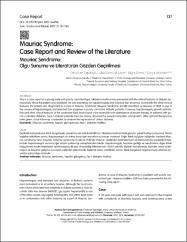| dc.contributor.author | Topaloğlu, Ömercan | |
| dc.contributor.author | Sezer, Sibel Demiral | |
| dc.contributor.author | Demir, Bilgin | |
| dc.contributor.author | Akarken, Derya | |
| dc.date.accessioned | 2020-12-19T20:30:18Z | |
| dc.date.available | 2020-12-19T20:30:18Z | |
| dc.date.issued | 2017 | |
| dc.identifier.citation | Topaloğlu, Ö., Sezer, S.D., Demir, B. & Akarken, D. (2017). Mauriac Syndrome: Case Report and Review of the Literature. Turkish Journal of Endocrinology and Metabolism, 21(4), 131-135. http://doi.org/10.25179/tjem.2017-56496 | en_US |
| dc.identifier.issn | 1301-2193 | |
| dc.identifier.issn | 1308-9846 | |
| dc.identifier.uri | https://app.trdizin.gov.tr/makale/TWpneU16WXpNdz09 | |
| dc.identifier.uri | https://hdl.handle.net/11436/5386 | |
| dc.identifier.uri | http://doi.org/10.25179/tjem.2017-56496 | en_US |
| dc.description.abstract | Diyabetik ketoasidozun klinik bulgularıyla prezente olan kötü kontrollü tip 1 diabetes mellitus tanılı genç bir erkek hastayı sunuyoruz. Hasta stabilize edildikten sonra, hepatomegali ve artmış karaciğer enzimleri açısından incelendi. Diğer klinik bulgular eşliğinde, hastaya Mau- riac sendromu tanısı koyuldu. Mauriac sendromu ilk olarak 1930'da Mauriac tarafından tanımlanmıştır ve kötü kontrollü diyabetik hasta- lardaki hepatomegali ve karaciğer enzim yüksekliği sebeplerinden biridir. Hepatomegali, büyüme geriliği ve sendromun diğer klinik bulgularının insulin tedavisinin optimizasyonu ile geri dönebildiği bilinmektedir. Kötü kontrollü diyabet hastalarında, hastalar cinsel matü- rasyon ve büyüme gelişme açısından yakından izlenmelidir. Optimal tedavi verildikten sonra, klinik bulguların regresyonunu izlemek açı- sından yakın takip elzemdir | en_US |
| dc.description.abstract | This is a case report of a young male with poorly controlled type 1 diabetes mellitus who presented with the clinical features of diabetic ke- toacidosis. Once the patient was stabilized, he was examined for hepatomegaly and elevated liver enzymes. Along with the other clinical features, the patient was diagnosed as a case of Mauriac Syndrome. Mauriac Syndrome, initially described by Mauriac in 1930, is one of the causes of hepatomegaly and elevated liver enzymes in poorly controlled diabetic patients. However, hepatomegaly, growth retarda- tion and other clinical features of the syndrome have been found to be reversible with optimization of insulin therapy. In patients with po- orly controlled diabetes, Type 1 diabetic patients must be closely observed for sexual maturation and growth. After optimal therapy has been given, close follow-up is essential to observe the regression of clinical features | en_US |
| dc.language.iso | eng | en_US |
| dc.rights | info:eu-repo/semantics/openAccess | en_US |
| dc.subject | Endokrinoloji ve metabolizma | en_US |
| dc.title | Mauriac syndrome: Case report and review of the literature | en_US |
| dc.title.alternative | Mauriac sendromu: Olgu sunumu ve literatürün gözden geçirilmesi | en_US |
| dc.type | article | en_US |
| dc.contributor.department | RTEÜ, Tıp Fakültesi, Dahili Tıp Bilimleri Bölümü | en_US |
| dc.contributor.institutionauthor | Akarken, Derya | |
| dc.identifier.doi | 10.25179/tjem.2017-56496 | en_US |
| dc.identifier.volume | 21 | en_US |
| dc.identifier.issue | 4 | en_US |
| dc.identifier.startpage | 131 | en_US |
| dc.identifier.endpage | 135 | en_US |
| dc.ri.edit | oa | en_US |
| dc.relation.journal | Turkish Journal of Endocrinology and Metabolism | en_US |
| dc.relation.publicationcategory | Makale - Uluslararası Hakemli Dergi - Kurum Öğretim Elemanı | en_US |


















